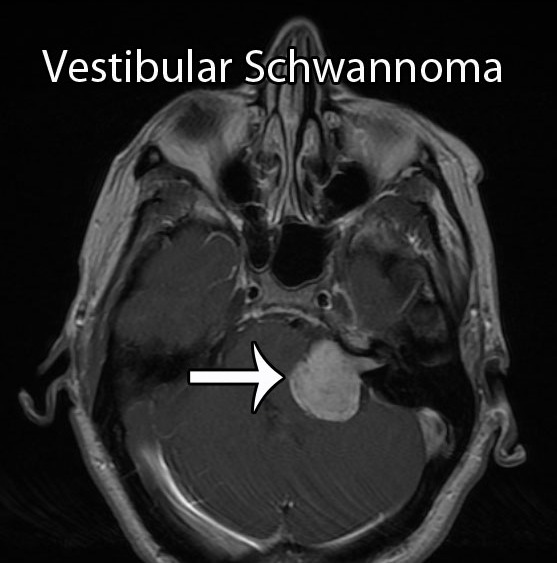
Vestibular schwannoma (also known as acoustic neuroma, acoustic neurilemoma, or acoustic neurinoma) is a slow-growing, intracranial extra-axial benign tumor that usually develops from the balance (vestibular) nerve or very rarely from the hearing (cochlear) nerve, supplying the inner ear. The tumor originates from an overproduction of Schwann cells, which normally wrap around nerve fibers to support and insulate nerves. As the tumor grows, it presses against the hearing and balance nerves, usually causing unilateral hearing loss, tinnitus (ringing in the ear) and imbalance/dizziness. Further tumor growth can interfere with the trigeminal nerve, resulting in facial numbness. A vestibular schwannoma can also press on the facial nerve giving rise to facial weakness and/or twitching. As these tumors increase in size, they eventually occupy a large portion of the cerebellopontine angle. If the tumor continues to grow, it will eventually press against the brainstem and the cerebellum, and will become life threatening or cause blockage of cerebrospinal fluid flow, a condition known as hydrocephalus. Unilateral vestibular schwannomas affect only one ear. They account for approximately 8% of all tumors inside the skull; one out of every 100,000 individuals per year develops a vestibular schwannoma. Symptoms may develop at any age but usually occur between the ages of 30 and 60 years. Unilateral vestibular schwannomas are not considered to be hereditary. Both males and females are equally affected by the disease. Bilateral vestibular schwannomas affect both hearing nerves and are usually associated with a genetic disorder called neurofibromatosis 2 (NF2). Half of affected individuals inherit the disorder from an affected parent and half seem to be the first in their family to have a gene mutation. Each child of an affected parent has a 50% chance of inheriting the disorder. Bilateral vestibular schwannomas are a principal clinical feature of neurofibromatosis 2, although other manifestations, including peripheral neurofibromata, meningioma, glioma, and juvenile posterior subcapsular lens opacities, are often present as well.
